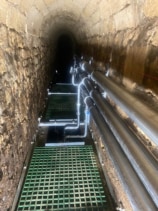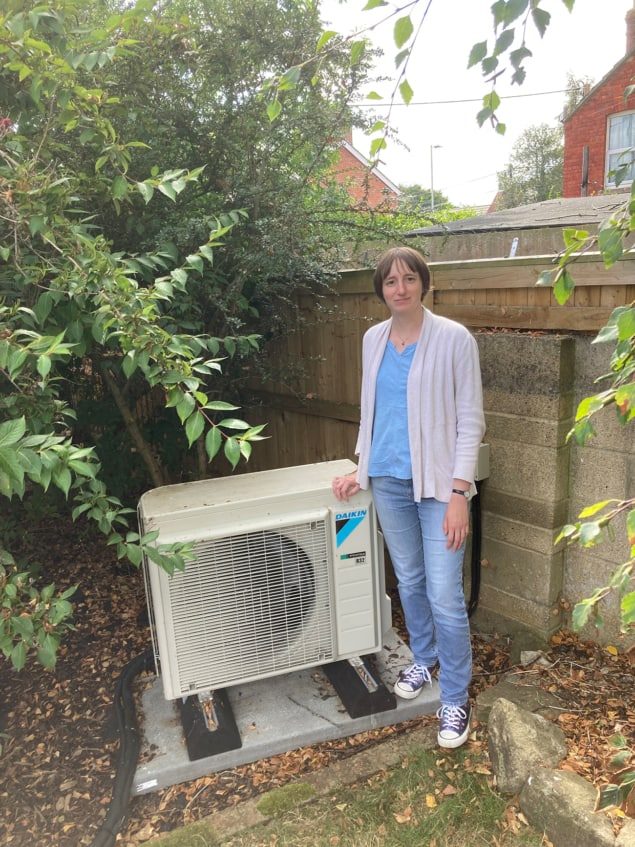With energy bills on the rise, plenty of people are interested in ditching the fossil fuels currently used to heat most UK homes. The question is how to make it happen, as Margaret Harris explains
Deep beneath the flagstones of the medieval Bath Abbey church, a modern marvel with an ancient twist is silently making its presence felt. Completed in March 2021, the abbey’s heating system combines underfloor pipes with heat exchangers located seven metres below the surface. There, a drain built nearly 2000 years ago carries 1.1 million litres of 40 °C water every day from a natural hot spring into a complex of ancient Roman baths.
By tapping into this flow of warm water, the system provides enough energy to heat not only the abbey, but also an adjacent row of Georgian cottages used for offices. No wonder that the abbey’s rector praised it as “a sustainable solution for heating our beautiful historic church”.
But that wasn’t all. Once efforts to decarbonize the abbey’s heating were under way, officials in the £19.4m Bath Abbey Footprint project turned their attention to the building’s electricity. Like most churches, the abbey runs from east to west, giving its roof an extensive south-facing aspect. At the UK’s northerly latitudes, such roofs are bathed in sunlight for much of the day, making them ideal for solar photovoltaic (PV) panels. Gloucester Cathedral – an hour’s drive north of Bath – has already taken advantage of this favourable orientation, becoming – in 2016 – the UK’s first major ancient cathedral to have solar panels installed on its roof.

To find out if a similar set-up might be suitable at Bath Abbey, the Footprint project worked with PhD students in the University of Bath-led Centre for Doctoral Training (CDT) in New and Sustainable Photovoltaics. In a feasibility study published in Energy Science & Engineering (2022 10 892), the students calculated that a well-designed array of PV panels could supply 35.7% of the abbey’s electricity, plus 4.6% that could be sold back to the grid on days when a surplus was generated. The array would pay for itself within about 13 years and generate a total profit of £139,000 ± £12,000 over its 25-year lifetime.
Home truths
Installing solar panels on the roof of Bath Abbey remains, for now, just an idea. “This is a viable option for the future – when the timing is right,” as Footprint project director Nathan Ward puts it. But for many people across the UK – ordinary householders as well as custodians of famous buildings – the timing is starting to look very urgent indeed. Driven by the Russian invasion of Ukraine, strong global demand for gas and various local factors, energy prices have been rising to unprecedented levels.
In forecasts released in August, the consultancy Cornwall Insight reckoned that the average UK household could spend £355 a month on energy in January 2023 if the situation did not change. The UK government’s Energy Price Guarantee, announced in September, provided some relief by subsidizing energy bills. Even so, between October 2021 and October 2022 the maximum unit price that energy suppliers are able to charge UK householders increased substantially, rising from 7p to 10.3p per kilowatt-hour (kWhr) for gas and from 21p to 34p per kWhr for electricity.

Bath physicist Alison Walker, who is director of the CDT, says that her team’s paper was, at the time, more of a hypothetical proposition to show that the abbey was serious about reducing its carbon footprint. Now, however, “the cost of energy has gone up so sharply, if you generate your own power, it may become a lot cheaper and less susceptible to energy price fluctuations such as we have experienced this year”, she says.
For householders who want to reduce their energy bills, their carbon footprints or both, solar panels are among the easiest and cheapest ways of doing it. Silicon-based PV panels are a mature technology, their price has plummeted over the past 10 years, and a rooftop array takes only a few days to install. But with government support for solar installations no longer available to householders, up-front costs are a barrier for many, and installers have long waiting lists.
Worse, solar panels are not suitable for all dwellings, either for technical reasons or because of how they look. “In the UK, we are very conscious about the aesthetics of buildings,” says Mike Walls, a physicist at Loughborough University’s Centre for Renewable Energy Systems Technology. “There are some buildings, particularly old ones, that people would not put solar panels on because they don’t look nice or they don’t fit in well with the overall appearance.” Gloucester Cathedral’s head of projects Anne Cranston notes that her team had to prove the panels would be “as ‘stealth’ as possible” before planning authorities would accept them.
In any case, slapping a few PV panels on the roof is seldom enough, on its own, to free householders from their dependence on fossil fuels. Obviously, the Sun does not shine at night, while the average direct normal insolation – a measure of the Sun’s energy per unit area – for northern Europe is no more than a few kWhr/m2. Even on the sunniest winter days, a typical UK rooftop PV array will therefore not produce enough energy to heat the house beneath it – as I discovered when I had solar panels installed on my own home in February (see box “One home at a time”).
If solar panels are not a complete answer, householders who want to end (or at least reduce) their reliance on fossil fuels – and who lack Bath Abbey’s convenient Roman hot water supply – must find other solutions. One option is to get rid of traditional gas-fired boilers and replace them with alternative heating systems. Indeed, as part of the UK government’s pledge to achieve net-zero carbon emissions by 2050, starting in 2025 it will no longer be legal to install gas boilers in newly built homes in the UK. But efforts to retrofit existing premises are proceeding slowly. So how are we going to “green” the UK’s housing stock?
Keeping the heat in
UK homes lose heat up to three times faster on average than homes in other European countries
The experts I spoke to for this article were united on one point: everything would be much easier if dwellings were better insulated. “Really, the answer is insulation, insulation, insulation, because that simply is by far the best way to reduce your energy costs,” says Walker. “Efficiency isn’t really given the attention that it should be,” agrees Zoe Robinson, a professor of sustainability at Keele University.
The figures are sobering. A 2020 study by the smart-heating technologies firm Tado° found that UK homes lose heat up to three times faster on average than homes in other European countries. Using data gleaned from 80,000 customers across Europe, analysts at Tado° concluded that a UK home heated to 20 °C on a 0 °C day loses an average of three degrees after five hours when the heating is switched off, compared with just one degree for a home in Germany.
This poor performance is partly due to the age of the UK’s housing stock. But Laurie Peter, an expert from Bath on using solar energy to generate fuels, says the problem extends to newer homes, too. “Successive governments have chickened out in terms of the regulations over building houses,” he argues, adding that this is true for a house’s overall carbon footprint as well as its energy use. “We are still more or less where we were in Victorian times in terms of house building and insulation, which is a disgrace, frankly.”
Due to this combination of older buildings and lax regulations, half of the 28.5 million homes in England have the same wall insulation as Bath Abbey – which is to say, none. Double glazing is more common, but according to the 2020–2021 English Housing Survey, 14% of English homes still lack it. Worse, retrofitting rates have fallen off a cliff. In the year 2012, some 2.3 million homes had new loft, cavity-wall or solid-wall insulation installed, but this number has dropped to under 200,000 per year after the government replaced a successful retrofitting programme with incentives that proved less effective.
One home at a time
I live in a two-physicist household, so when we replaced our gas boiler with a heat pump and installed solar panels on our roof, we naturally treated the installation as a scientific experiment with results we could monitor over time. Would we use less energy? And would it make any difference to our bills?

Our Edwardian brick terraced house is relatively efficient for its age, with double-glazed windows and loft and cavity wall insulation. Even so, switching to a heat pump required preparation. After measuring our rooms and windows, the installers (a local plumbing firm that does heat pumps as a sideline) calculated that we would need an 8 kW heat pump, a new high-efficiency hot water tank, and longer, double-wide radiators in every room.
Strong demand put the installers on a tight schedule, so when they offered us a slot in mid-January, we accepted even though it meant no heating for up to two weeks (this would have been harder for households containing small children or people with disabilities). High demand and supply-chain problems likewise delayed the solar panel installation to February. But once the retrofit was complete, it worked beautifully, as this graph of the house’s energy usage from January 2021 to August 2022 shows.

The heat pump started working on 19 January. For the rest of the winter and into early spring, our house’s average daily energy use (blue line) was around half that of the same period in 2021 (note that the 2021 dataset is based on quarterly or bimonthly readings, while usage from February 2022 onwards was recorded weekly). The solar panels installed on 3 February had a smaller effect, partly because a lack of space and budget for batteries meant that some electricity got exported to the grid (green line) rather than used in the house (pink line). The house also continued to import electricity (orange line) in the evenings, on cloudy days and at periods of high demand. Still, by late spring and early summer, the panels’ average daily production routinely exceeded the house’s average daily use – a heartening result.
The financial benefits are less clear-cut. The UK’s electricity comes from a variety of sources, including renewables, gas, nuclear and (rarely) coal, but electricity prices are tied to the most expensive source (currently gas). UK electricity prices also include environmental taxes that do not apply to gas despite the latter’s higher environmental cost. So while our house is using less energy, the energy it continues to import is considerably more expensive than gas on a per-unit basis. Selling electricity from the solar panels helps, as does a heat-pump grant from the UK government’s (now-closed) Domestic Renewable Heat Incentive scheme, but this part of the problem is ultimately about politics, not physics.
Pumping heat
As well as saddling householders with higher energy bills and increased carbon emissions, poor insulation limits options for changing how homes are heated. The UK government’s plans for achieving net-zero carbon emissions rely heavily on replacing natural gas boilers with heat pumps, with a target of 19 million heat pumps by 2050 compared with around 250,000 today. It is a strategy that, in some ways, makes sense.
Heat pumps operate on the same principles as refrigerators, except they pull heat in from the air or ground outside to make the inside warmer. And thanks to the laws of thermodynamics, they are remarkably efficient: for each unit of electricity they take in, they kick out 3–4 units of heat (see box “How heat pumps work”). The technology is also commercially mature, with major manufacturers such as Mitsubishi Electric and Daikin producing a range of models.
Unfortunately, certain aspects of the UK’s current energy set-up throw a spanner into the works. Zhibin Yu, an engineer at the University of Glasgow, sums up the situation. “In the UK, most of our houses are connected to a gas grid, so our central heating systems are designed for boilers,” he explains. By circulating water at 60, 70 or even 80 °C, a traditional natural-gas boiler can keep a house toasty (albeit at high cost) even if the radiators are small and the walls and loft badly insulated.
The performance of a heat pump, in contrast, depends on the temperature difference between the heat pump’s source (such as the outside air) and its supply (the water or air circulating around the heating system). As Yu explains, if the gap is big, the performance is low. To achieve the highest energy efficiency, you’d ideally want your supply to be between 35 and 45 °C.
That might be fine for underfloor heating systems like those in use at Bath Abbey. But the heat-transfer area of standard-sized radiators is seldom large enough to keep a room warm if water is circulating round them at a relatively tepid 45 °C. As a result, occupants may end up feeling uncomfortably chilly – not great news for anyone who has spent time and energy ripping out their gas boiler and installing a heat pump.
Bigger radiators and better insulation can fix this problem – for a price. According to Yu, an air-source heat pump powerful enough to heat a typical semi-detached house generally costs between £3000 and £5000. But a complete installation, including retrofitting radiators, can cost more than twice that, making the whole project as much as four to five times more expensive than installing a new boiler. “That is a challenging situation,” he concludes.
How heat pumps work

Unlike standard electric heaters, which work by passing current through a resistive wire, heat pumps operate on the same thermodynamic principles as refrigerators. At their heart is a working fluid such as difluoromethane that vaporizes at a relatively low temperature and pressure. This allows the fluid to absorb heat even from low-temperature sources (Qsource) such as soil, water or the outside air in winter.
After it absorbs heat, the working fluid turns into vapour and passes through a compressor, which increases its temperature further, and a condenser, which turns the warm, high-pressure vapour into a liquid. The heat released in this phase change (Qsupply) is then transferred to a central heating system, and afterwards to the building via air blown through ducts or water circulated through radiators or underfloor pipes. Once the working fluid has released most of its heat, it is sent through an expansion valve, reducing its pressure (and therefore its temperature) so the cycle can begin again.
Deploying hydrogen
One alternative to swapping boilers for heat pumps might be to change the boilers’ fuel to hydrogen. Unlike natural gas, hydrogen releases no carbon dioxide when burned, and in principle it can be produced in an eco-friendly way. This is the rationale behind the recently completed HyDeploy project, in which several hundred UK homes burned a blend of natural gas and up to 20% hydrogen by volume.
The pilot study was designed to make the transition as painless as possible for householders. Luckily, modern gas boilers are designed to cope with up to 25% hydrogen, so few homes needed retrofitting. Both phases of the pilot took place across limited geographic areas (near Keele University in Staffordshire and Winlaton in north-east England), making it possible to address residents’ initial concerns about safety and cost individually.
Robinson, who is involved in HyDeploy as a social scientist at Keele, says that so far, her survey data indicate a high degree of public acceptance. “The majority of people really aren’t that bothered, particularly because with blended hydrogen, they don’t have to do anything,” she says. “It just happens.”
Those are the good points. Here are some of the downsides. UK regulations generally restrict the amount of hydrogen in the gas grid to below 0.1%, so rolling out higher fractions would require a change in policy. Another problem is that hydrogen is much less dense than methane, which means that blending in 20% hydrogen by volume (not mass) reduces carbon emissions by just 7%. What’s more, increasing the fraction of hydrogen further would require not only new boilers but also replacement pipes, since hydrogen in high concentrations causes steel to become brittle.
A further issue is that most of the 87 million tonnes of hydrogen the world produces each year comes from steam reformulation of methane, making the technology “grey” rather than “green”. The main green way of producing hydrogen is to use electricity from renewable sources to split water into oxygen and hydrogen. But Peter, the solar-fuels expert at Bath, says that finding enough renewable electricity to do this at scale is tricky. “If you try to generate that all by solar-generated electrolysis, this is an impossible task,” he says. “It just can’t be done.”

Life in a carbon-neutral world
Peter points out that around 40% of the world’s hydrogen is currently used to produce fertilizer, with much of the rest going into oil refining. Both industries are trickier to decarbonize than domestic energy consumption, and Peter argues that household hydrogen burning doesn’t make logistical sense either. “Generating ‘green’ hydrogen by electrolysis, sending it down the pipe to you, and you burning it, is energy inefficient compared with sending ‘green’ electricity to your house,” he explains. “I don’t see hydrogen, myself, becoming a major player in terms of what’s going on in your house.”
In the long run, Robinson agrees that domestic hydrogen “doesn’t make sense” in efficiency terms. However, she points out that installing alternative heating systems will take time. “One of the issues at the moment is that when someone’s boiler crashes, the response will be to just replace it with another boiler,” she says. “There’s a skills gap in terms of heating engineers and the advice that people get.”
In Robinson’s view, hydrogen could act as a “stepping-stone”, reducing dependence on fossil fuels until heat pumps become cheaper and more common. “It could be that [once] blended hydrogen creates that market for green hydrogen production, then you start to use green hydrogen somewhere else in the energy system.” In this respect, she sees parallels between green hydrogen and offshore wind energy, which was expensive until countries and manufacturers started investing in it, creating enough demand to drive prices down.
From heating systems to energy systems
Apart from heat pumps and hydrogen, a few other technologies could smooth the path to lower-carbon homes. High-efficiency PV panels that use crystalline silicon and materials known as perovskites in a tandem structure are due to go into commercial production next year, and Walker thinks they will make a “serious impact” on the cost of solar energy. Walls is similarly enthusiastic about the prospect of developing integrated solar panels for electric cars and panels that look like standard roof tiles, to reduce aesthetic objections to solar power. “Of all the renewables, PV has the best chance of being attractive at a residential level,” he says.
Another area attracting lots of innovation is energy storage. Many domestic solar installations already incorporate lithium batteries for when it’s cloudy or dark. Larger-scale storage is also becoming a reality, and heat-pump technology isn’t standing still either. At Glasgow, Yu has developed a new, flexible pump that incorporates a heat-storage device between the condenser and the expansion valve.

This device takes some of the heat that would otherwise be lost and makes it available for the heat pump’s operations. For example, the auxiliary heat could be used to defrost the heat pump’s outdoor unit, as is regularly required when ambient temperatures fall below about 6 °C. Overall, Yu thinks a 10% improvement in efficiency is feasible with his design, which he believes would “make a big difference when you look at the payback period” for installing heat pumps.
Thanks to its in-cycle auxiliary heat storage, the flexible heat pump would also open other possibilities, such as exploiting the heat we throw away every day. “For example, when we have a shower,” Yu observes, “we heat the water to 70 or 80 degrees, mix it with cold water to get it down to 35–40, and then it leaves the shower at 20–30 – the heat it contains is just thrown away in the drainage.”
A better approach might be to consider our homes as integrated energy systems. “You basically try to manage the energy flows in your house, heating and cooling,” Yu says. “You need the fridge, you need the freezer, you need the boiler, you need the air-conditioner – you throw a lot of heat away, you then extract a lot of heat from the air. Why don’t we integrate these processes?”
Setting a precedent
Back in 2016, when planning authorities decreed that Gloucester Cathedral could, after all, have solar panels on its roof, they warned project director Cranston that the decision did not set a precedent for other historical buildings. Six years on, Cranston says “things have changed significantly” both at the planning authority and within the Church of England. “NetZero makes clear the challenge ahead of us all,” she says. “Heritage buildings have to play their part.”
At Bath, Ward stresses that the way is still open for the abbey to follow suit. The church’s Roman-inspired geothermal heating system is, he says, “very much seen as a first step in moving Bath towards zero carbon”, with the city council and conservation bodies eager to pursue additional options. The city’s Roman Baths complex is already installing its own version of the abbey’s heating system, and Ward and his team are keen to put solar panels on the roof of their offices.
“As far as we know, there are no sustainable energy solutions currently in the city, so we are in early discussions with the council and other stakeholders to investigate how quickly we could install a system,” he says. “The hope is that we can continue to collaborate to speed progress.”













